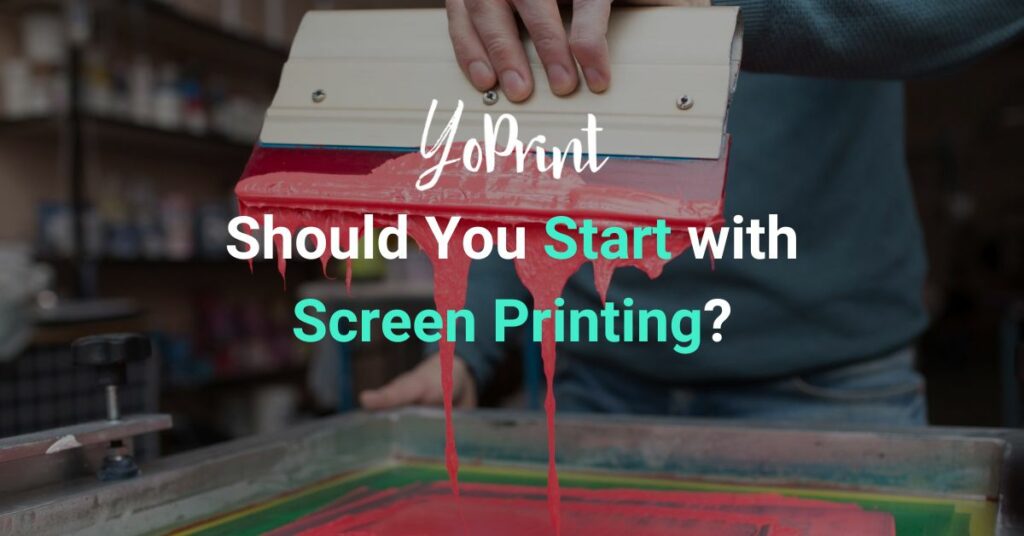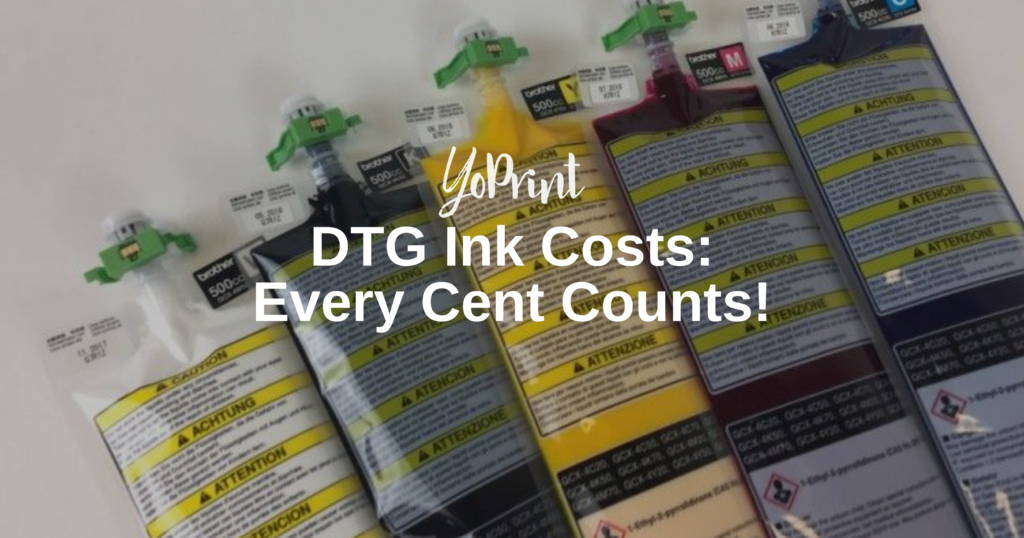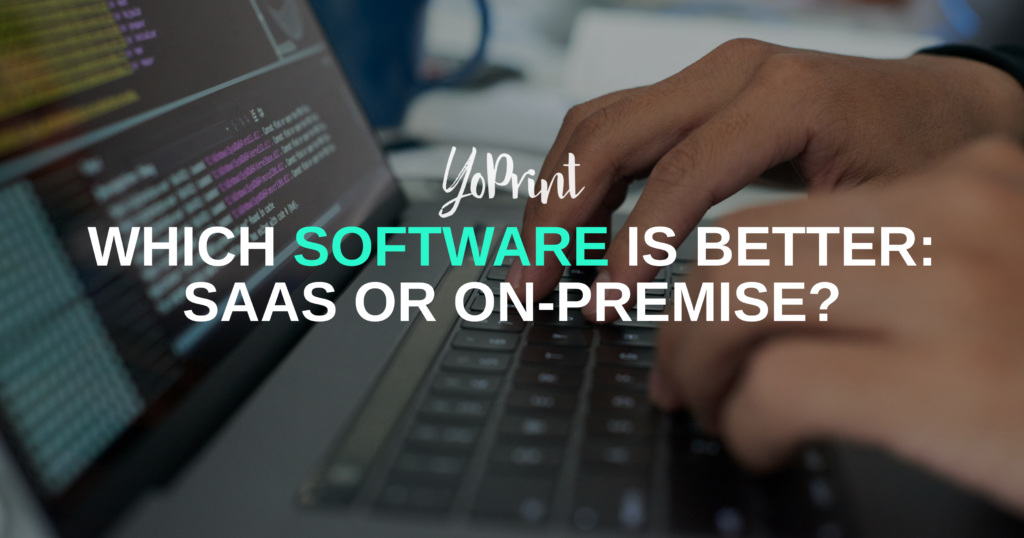So you’ve heard that printing custom shirts is a lucrative business, and you’re looking to get your start on it. Screen printing is mentioned relatively often for a variety of reasons. With its impressive ability to handle bulk orders, print vibrant colors with little difficulty, and low startup costs, screen printing is an excellent choice for printing custom garments.
But should you consider starting your business with screen printing? Do its pros outweigh the cons, and will it be enough to justify taking it up for your printing business? Let our article give you a rundown of what it’s all about and whether it’s just what you need.
What is Screen Printing?

Screen printing, sometimes called serigraphy, is one of the oldest printing methods dating back over a thousand years. It’s a process of creating a design onto a substrate by pushing ink through a stenciled mesh screen using a squeegee. Mesh screens come in all shapes and sizes for various jobs, while different mesh counts will alter how your design looks when it’s printed.
Screen printing is a labor-intensive process that requires you to prepare screens before you can start printing. You’ll need to choose the correct mesh count, have a specific number of screens based on how many colors you’ll use, and then methodically coat each one with emulsion and have them exposed to UV light with the design stencil. This allows the inks to be driven into the desired pattern through the mesh.
Once all the screens are ready, you’ll wash them out to reveal the stencil. After drying, you can mount them to the printing press and start printing onto the garment. For every color, you’ll need to use separate screens that must line up with the design. With the squeegee, you’ll force the ink through the mesh stencil, coating the substrate with ink.
Screen printing delivers excellent results on a wide range of substrates, with various techniques that you can use to create all kinds of unique designs, such as halftones to simulate multicolored shades. As screen printing has been around for a very long time, it’s been able to evolve and improve over the years, allowing the labor-intensive process to be more efficient thanks to automation and vast improvements to its workflow.
What You’ll Need for Screen Printing
You’ll need all the right tools for the job if you want to produce great-looking garments. We’ll give you a rundown of what equipment you need to start screen printing.
Mesh Screens
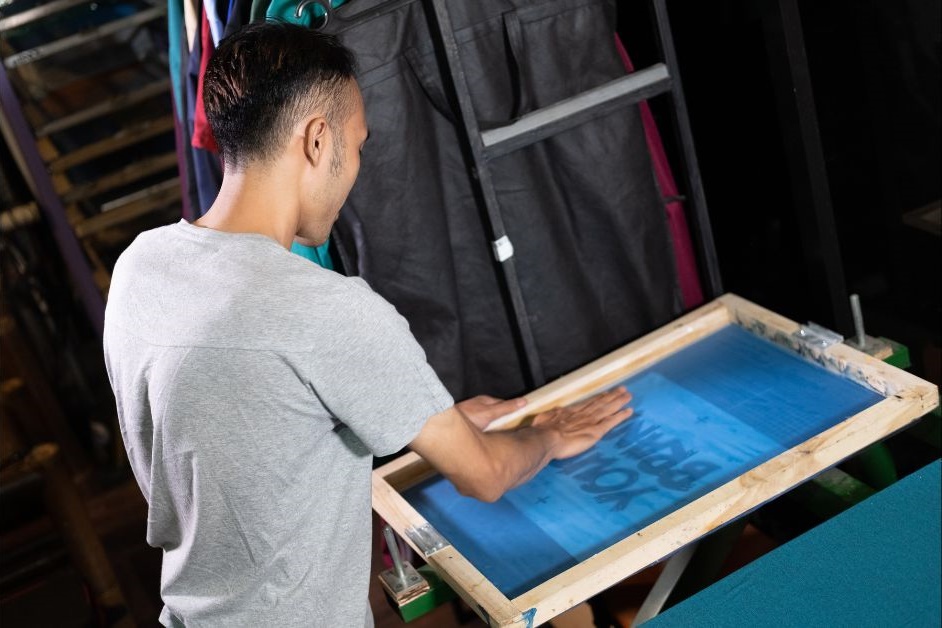
The mesh screens are your most important component for screen printing. What will you print if you have a press but no screens to work with?
There are two types of mesh screens: wooden frames and aluminum frames. Wooden frames are cheaper to purchase but can warp over time due to long-term exposure to water during the cleaning process. Depending on the type of wood used, some wooden frames can be hefty to lift, which can cause physical strain over time if you don’t handle them carefully.
In contrast, aluminum frames are lighter and resistant to warping, allowing you to reuse them over and over again with ease. With the right professional tools, you can easily remove the mesh, clean the frame, then re-stretch it, further improving the frame’s overall durability.
Mesh screens are also differentiated by mesh counts, which is the number of threads of mesh crossing per square inch. The rule of thumb is the higher the mesh count, the finer the threads and gaps on the screen. For example, a 110 mesh screen will have 110 threads crossing per square inch.
You’ll also need to factor in the viscosity of your inks with specific types of screens; thicker inks on a screen with a high mesh count will result in barely any ink passing through the mesh.
The standard mesh sizes are 110 and 156. 110 is best for large typography prints or more prominent spot colors, while 156 is ideal for more detailed prints. Other mesh sizes are available. If you’re using specialty inks like glitter, you may need a smaller mesh count; particles within specialty inks won’t pass through screens with high mesh counts.
The difference in mesh counts can also affect your emulsion exposure times. Smaller mesh counts can hold more emulsion, meaning it takes longer to be exposed to sunlight.
After each print run, you can reclaim used screens and reuse them for future jobs. It’s usually recommended that you wash screens as soon as a job is done to prevent the inks from setting into the mesh and preventing it from being reclaimed and reused.
Screen Printing Press
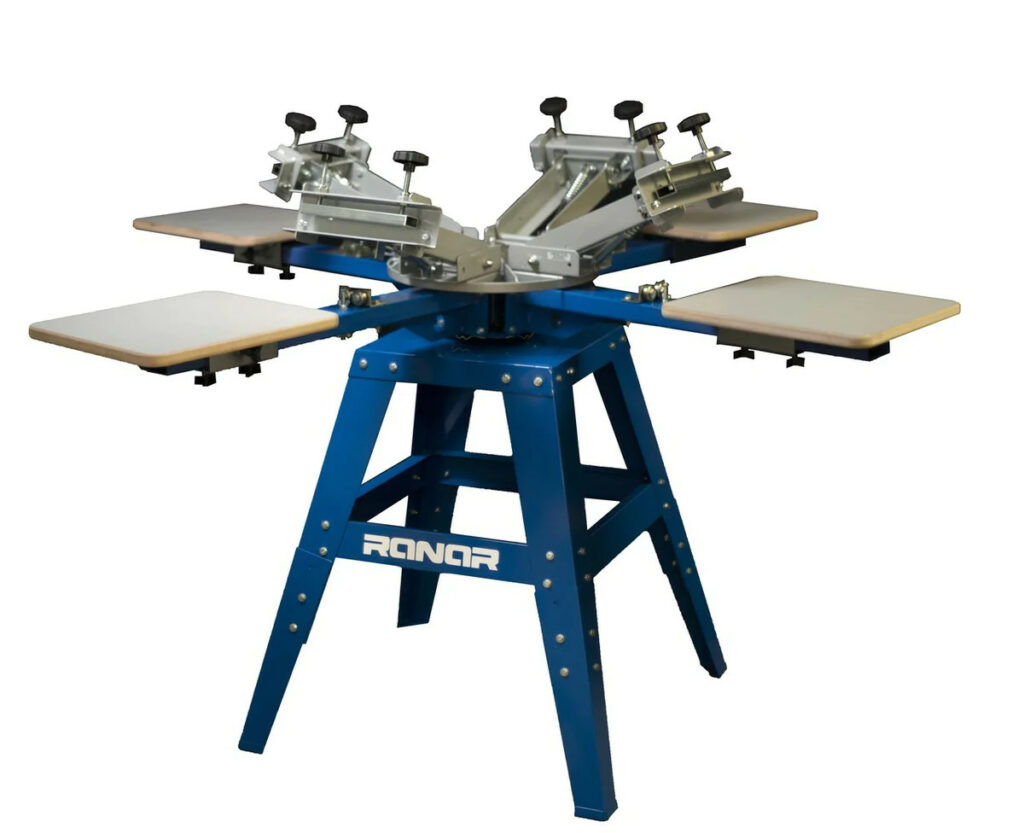
The screen printing press holds your screens and substrates in place, allowing you to print your design on the substrate. Most presses take on the form of a thick countertop stand with a ring of multiple platens (to mount the substrates) and hinge clamps with swivels (to hold the screens and position them over the substrate).
The press is an essential piece of equipment that helps ensure the screen is in place when you’re printing, preventing it from moving too much while you’re applying the ink onto the substrate. Screen printing presses are priced based on the number of colors and platens (or stations) they support. For example, a 4/4 press supports four colors and four platens/stations.
Manual presses are the most affordable option for those new to screen printing and are printing from their home or garage. Semi-automatic presses are partly automated but require human input to do specific tasks, such as swapping out garments from the platens. Fully automatic presses also exist, but these cater to large-scale printing and are, thus, very expensive.
Screen Printing Inks

Two types of inks are generally used for screen printing: water-based inks and plastisol. As the name implies, water-based inks comprise water and dye pigments. Because they are water-soluble, they produce a very soft hand since the inks are absorbed by the substrate and don’t “sit” on the surface; this has the benefit of keeping the garment “breathable.” It’s best used on light-colored garments, intricate designs, or light, muted colors. You’ll use a spatula to mix your inks and apply them to the screen.
You can buy water-based inks in either ready-for-use (RFU) or high-solid acrylic (HSA) forms. RFU inks come in a wide range of vibrant colors you can choose from, making them suitable for light-colored garments and even darker ones (requiring a white underbase). Meanwhile, HSA inks contain a thickening binder that gives them plastisol-like properties, making them ideal for complex prints such as halftones.
On the other hand, the thick, opaque plastisol inks are liquid plastic. It comprises PVC particles suspended in a liquid plasticizer; as such, it doesn’t evaporate very quickly and is relatively easy to use. Plastisol can also create various colors and special effects, such as glitter or metallic paints. It’s best used for simple but vibrant designs and dark-colored garments.
Plastisol is still widely used by screen printers in North America. It’s well regarded as versatile on various substrates, has a long shelf life, and is very cost-effective for bulk orders. Though its thick feel does get in the way of a garment’s breathability, plastisol-printed designs are durable when adequately cured.
Emulsion
Screen printing emulsion is a light-sensitive liquid that creates an ink-resistant frame for your design. You’ll need to apply the emulsion on both sides of the mesh screen, then place your printed design (printed on acetate paper) over the top part of the coated screen before putting them together under a UV light source for exposure.
When the emulsion is exposed to UV light, it slowly hardens – except for the areas covered by your design. You can easily wash off the unhardened areas to reveal the image of your design, allowing inks to be pushed through the mesh in those areas. The other areas covered by the hardened emulsion will not allow ink to pass through the mesh and onto the substrate.
Various types of emulsions cater to different uses. Diazo emulsions, for example, have a longer exposure time but are more forgiving with mistakes. They’re also much cheaper, making them a good choice for new screen printers. You need to add Diazo powder to the emulsion before you open and use it for the first time – this is known as “sensitizing” the emulsion.
If you’re using liquid emulsion, having a scoop coater can be very helpful. This tool allows you to apply an even layer of emulsion to both sides of the mesh screen. There’s a technique to use a scoop coater to apply your emulsion layer correctly.
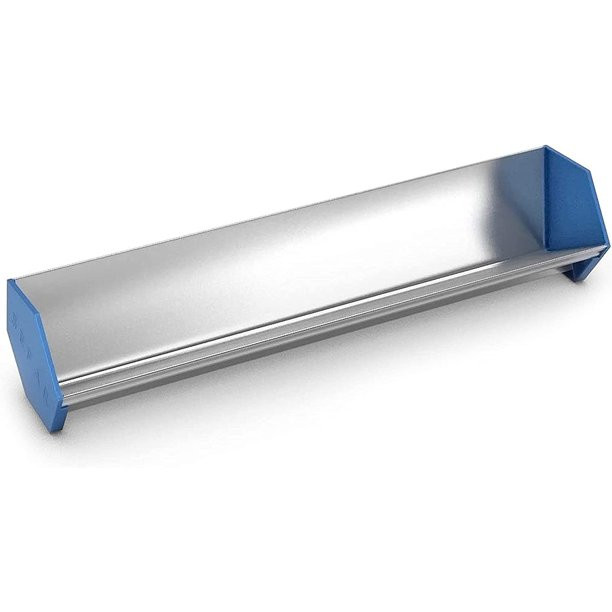
There are also capillary films, or emulsion sheets, which you can use. Instead of a liquid-like substance, these come in the form of films, making them an easy-to-use and mess-free way to coat your screens with emulsion. It can have characteristics of commonly used emulsions while having different levels of thickness for specific applications. Capillary films might be slightly more expensive to use than standard liquid emulsions. Still, these are recommended for new shop owners, special applications, or jobs needing the most accurate emulsion thickness.
Squeegees

A squeegee is a handheld tool made of a wooden or aluminum handle attached to a blade made of rubber (usually neoprene, a synthetic rubber) or plastic (generally elastomers, which are highly flexible and resilient plastics). You’ll use these to drive the inks through the stenciled mesh screen and onto the substrate to print the design. As you drive the squeegee along the mesh, you’re also keeping the mesh in contact with the substrate to allow the inks to reach it and even remove any excess ink from the screen. All these can influence how the print turns out.
Buying a squeegee might seem straightforward, but there are various factors to consider beyond just the handle and the technique of driving the inks through the mesh. For instance, you’ll need to consider the blade’s durometer – the “hardness,” so to speak, or flexibility of the squeegee. With a “softer” blade (low durometer score), you’ll deposit a thicker ink film onto the substrate, while “harder” blades creates a thinner but sharper ink film.
Squeegees also come in different layer types. Single-layer squeegees are considered general-purpose squeegees for depositing ink. Meanwhile, triple-layer squeegees (sometimes called composite blades), made up of a single hard blade sandwiched between two softer ones, are used for fine detail and high-speed automatic presses.
Squeegees also come in varying shapes and sizes, so you’ll need to have the right squeegees for the task at hand. A general rule you can follow notes each edge of the squeegee blade should extend by one-half inch beyond the edge of the stencil.
Flash Dryer/Heat Gun/Heat Press
For setting or curing inks, you have a few choices to pick. For newcomers, heat guns are a portable way to set inks for multicolor jobs or even to cure inks for garments that are almost ready to go. However, the main drawback of using a heat gun is the inconsistent heat applied to setting and curing inks. You could potentially cause color changes or shifts because you applied too much or too little heat in some areas.
Flash dryers are commonly used for setting inks on a garment. Setting inks refers to drying a coat of ink that’s been applied to the garment so that you can apply another layer of ink (in a different color) to it without causing any color mixing, shifts, or some other issue. You’ll just need to position the flash dryer over a platen for anywhere between 3 to 15 seconds, depending on the flash dryer you use.
You can also use flash dryers for curing, which is usually not recommended as it can affect overall consistency and cause problems such as design washing out at the edges. For consistent curing results, a flatbed heat press or a conveyor dryer (for larger setups) is your best option.
Exposure Unit
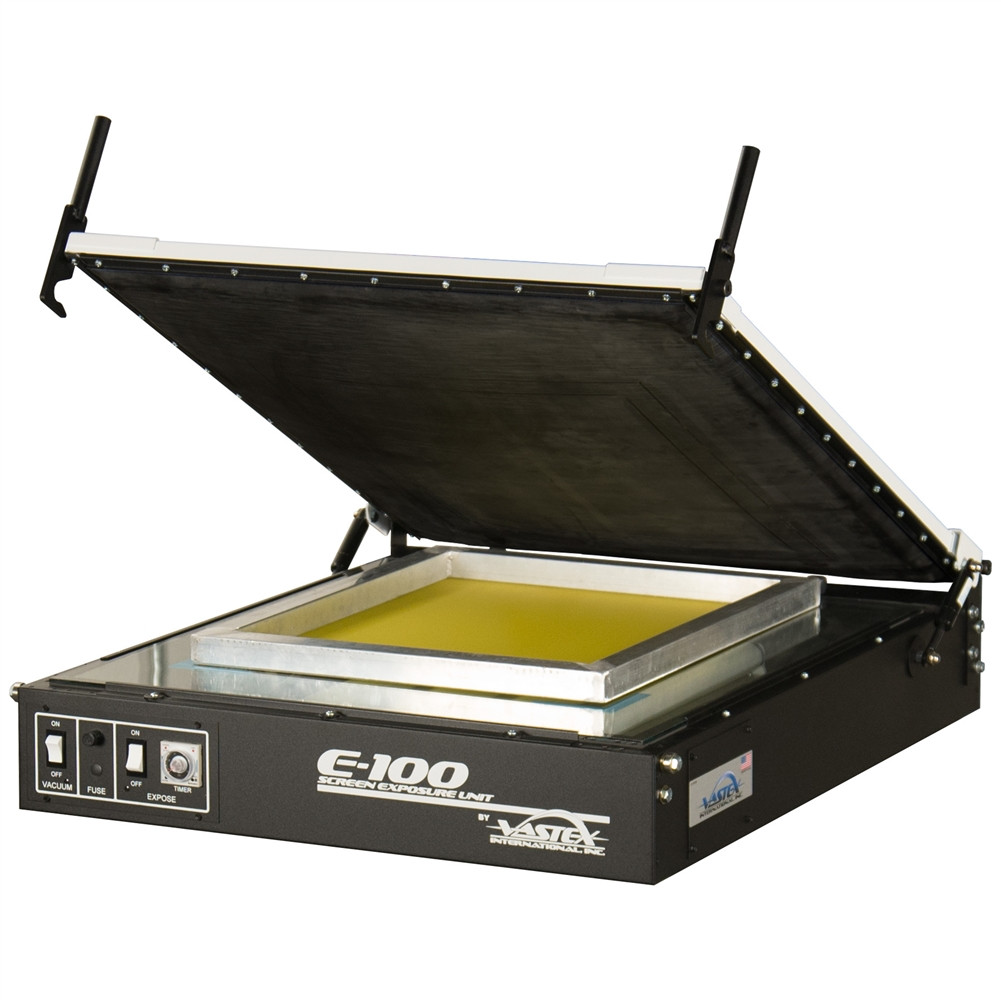
The exposure unit provides a constant UV light source to cure the emulsion around your design and create the stencil you need. Having a suitable exposure unit can be the difference in preparing high-quality screens.
Various exposure units use one of three types of lighting. The most commonly used type is the metal halide exposure unit, which uses a high-wattage single-source bulb to produce intense UV lights. Because of this intense light exposure, these are typically used to create highly detailed stencils.
However, metal halide bulbs are costly and become significantly weaker over time and with frequent use. This can cause your exposure times to increase over time as their intensity gradually reduces. Even turning them on and off can reduce their lifespan even further. You could potentially see your overheads increase (especially when the recommended replacement time is between three months to a year).
LED exposure units are gaining popularity thanks to their fast exposure times using light-emitting diodes (LEDs). They generate consistent UV light that doesn’t weaken over time while keeping power consumption to a minimum – approximately one-fifth of the amount of power metal halide units uses. As such, you can benefit from the strengths of metal halide exposure units at a fraction of your overall overhead costs.
You could build an exposure unit of your own, but it does come with caveats – one being inconsistent exposure results or significantly increasing exposure times.
Printing Your Designs
The simplest way to stencil your design to the mesh screen is to print your design on a transparent piece of acetate film. You can easily use a regular desktop inkjet printer to print the design in black ink. Make sure that, once printed, no light can pass through the opaque design. Any of these pinholes, as they’re called, can cause the emulsion to be exposed in the wrong places, which can cause poor results when you take the stenciled mesh screen for printing.
There is also specialized equipment that can create a stencil directly to the screen – no acetate paper is needed. However, these machines are fairly large and come with a very hefty price tag to boot.
Other Supplementary Equipment
Screen printers also use other equipment to help them with their printing jobs. Use of this equipment varies from shop to shop, but having them can provide you with some level of convenience when printing and even cleaning up.
- Washout booth: Gives printers a space to clean their screens while providing a safe way to dispose of chemicals and emulsion by-products. Booths come in various sizes to accommodate multiple screens.
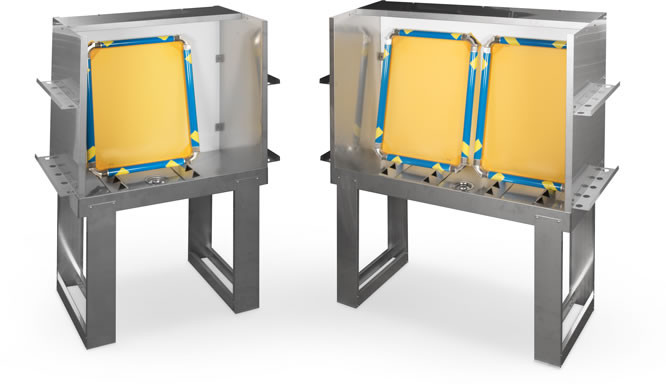
- Spot cleaning gun: During print runs, you might have occasions where you accidentally get ink onto the garment. The spot-cleaning gun has an adjustable high-pressure spray to allow you quickly clean up ink spots on a garment.
- Platen adhesive: Printers use these adhesives to prevent a garment loaded on a press’ platen from moving too much during print jobs. They’re available in spray or liquid form.
- Test pellons: These “test squares” have a texture similar to garments, giving you a test bed to see how specific colors will turn out on certain fabrics.
- Temperature gun: These give you a reading of a garment’s surface temperature. These are usually needed for gelling or curing inks if you’re not using a flash dryer or a heat press.
- Press cart: You can mount your smaller presses onto wheeled press carts to move the presses around for storage, make way for other presses, and so forth.
- Dunk tank and emulsion stripper: Used for reclaiming used screens, you’ll fill a tank with water and mix it with a liquid emulsion stripper. You can place a few screens into the tank, leave them for a while, remove them, and wash them clean with a hose or pressure washer.
A Shop Layout That Works
Now that you know what you need to start screen printing, how do you put them together?
A good print shop prioritizes a clean, efficient, and safe layout that helps to maximize productivity and profits. You’ll need to make good use of your space, as a lot of screen printing equipment does take up a good deal of real estate in your shop. If you’re printing from home, most entry-level equipment doesn’t take up that much space, but it can still get cramped if you don’t plan your layout carefully.
You also need to think about power sources and outlets. Different equipment has different energy ratings, and because everything will be everywhere in your shop, you’ll need to ensure that power cables and extensions are placed strategically. This way, they won’t interfere with movement or cause unintended power fluctuations from using the wrong power points.
Most shops may situate their presses in a central location in the main printing room, giving you and your team sufficient room to walk around them. It also gives everyone access to other auxiliary equipment or rooms where other equipment is located.
Manual Rows
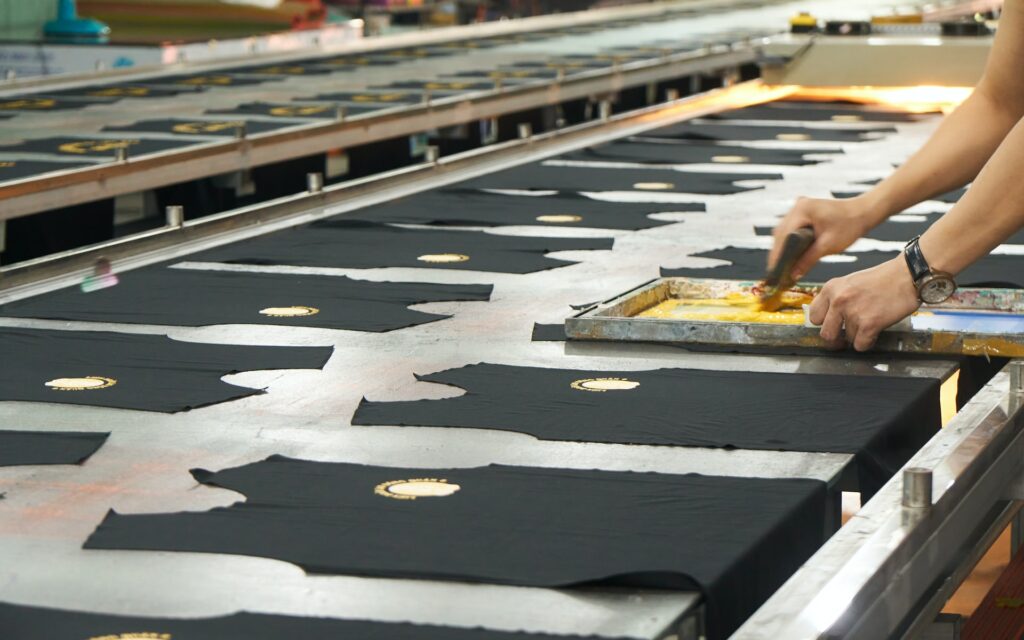
This simple arrangement has rows of platens, or single station presses, neatly lined up like aisles or a very long, flat table, with space between rows for employees to move around. Screen printers will manually print designs on garments, going from one side to the other.
The standard method is to have one (or more) person(s) holding a screen and applying the required inks to each garment along the row. They are followed closely by a person with a heat gun to allow the inks to cure.
Instead of having a person carry a screen from one end to another, you can alternatively set up a row of affordable presses to hold screens in place. Doing so ensures consistency doesn’t take a hit when printing multiple garments, especially since you and your team might be going fast to finish up customer orders.
However, your primary concern would be finding a way to cure the inks properly. Using a heat gun isn’t the best option due to the inconsistency of curing inks. You could have a separate row of flash dryers or heat presses to do the job.
Circular Arrangement
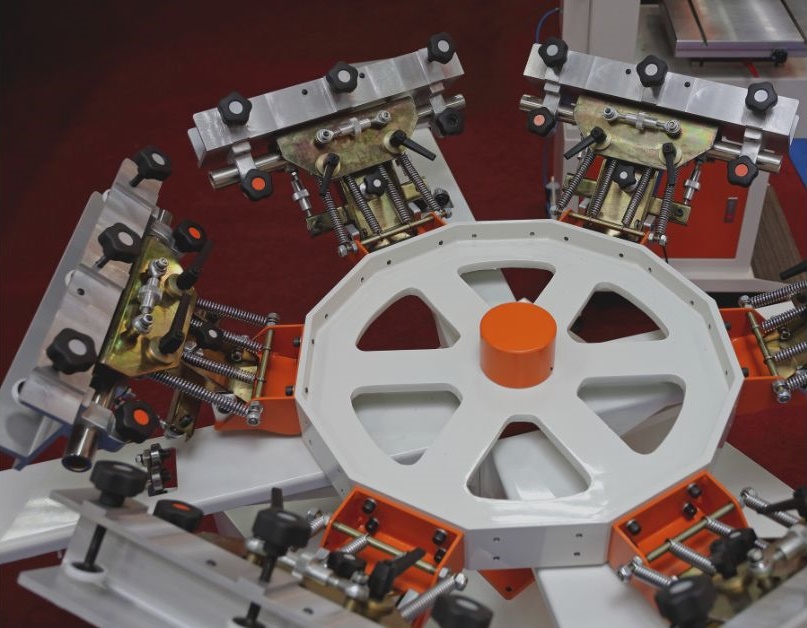
The circular arrangement mainly refers to using circular or carousel printing presses for your screen printing. These presses are common in many screen printing shops, as they come in many configurations for different shop needs. There are also larger circular presses with more platens that allow your team to print more garments simultaneously.
With circular presses, you’ll need to plan your shop layout carefully. Their shape, especially larger units, can take up a significant amount of space. You’ll need to ensure that your printing space can accommodate the presses, the people operating them, and whatever auxiliary equipment you need to get a print run done.

Automation
Automated press arrangements emphasize speed and efficiency without sacrificing print quality. While they cost a considerable amount of money, they give users an unprecedented boost in overall productivity. They can easily print garments at a steady rate without sacrificing print quality, allowing you to finish multiple batches in record time.
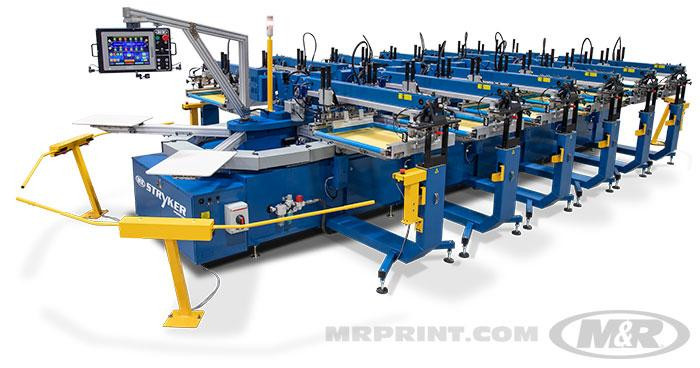
Due to their large size and exorbitant price tags, automated setups are usually found in larger screen printing shops with many employees to manage the equipment.
Picking the Right Setup
What will you need for your business? Are you starting small and taking small orders from friends and family? Or are you going big and need all the equipment to produce great-looking garments? This section is here to help you.
Essentials Only (EO)

For new shop owners, the EO setup consists of only the most essential pieces of equipment to start screen printing. This setup gives you the following equipment:
- A manual screen printing press: A simple station is priced from $200, depending on the number of colors and stations you need.
- Desktop printer and transparent acetate film/paper for your designs: We’ll assume you have your own desktop printer; 50-sheet acetate packs can go for $30 or more.
- Mesh screens: Screens with a 110 and 156 mesh count should be sufficient for new printers; aluminum frames cost $30 and above. You can also get a starter kit of 6 screens for $300.
- Inks and liquid emulsion: A gallon of plastisol ink can cost you $60 and above, while water-based inks can go for $65 a gallon. As for liquid emulsion, it goes for $60 per gallon; emulsion remover costs around the same price.
- Squeegees: Wooden handle squeegees are relatively cheap, going for $6 or higher, depending on their durometer. Meanwhile, aluminum handle squeegees are priced from $18 and above.
- Scoop coater for the emulsion: You can get a 6” scoop coater for $11 or more. Longer ones, such as a 14” length, can cost about $20 and higher.
- Screen racks/carts: You can either build a rack of your own or buy a simple wheeled rack for about $30 – just make sure that it can take the press’s weight into account before buying one. Dedicated screen printing press racks can go for $400 or so.
- Flash dryer for setting inks: A simple 16”x16” flash dryer from Amazon can be as low as $140. Added bells and whistles, such as a temperature display, can increase the price to about $165.
- Exposure unit: A simple exposure unit can go from $200 upwards; units with a lid and a vacuum seal to keep the lid sealed tight can be more costly. You could have your own DIY setup using metal halide exposure bulbs, attached to your own light fixture in a light-safe room. An LED metal halide bulb can go from $30 and higher.
- Heat press for curing: Standard flatbed heat presses can cost $150 or higher.
- Cleaning supplies: Brushes, hoses, and degreasers (among other things) come at various costs.
If you’re lucky, you can get an EO setup for under $2,000 – such as this Riley Hopkins kit offered by ScreenPrinting.com. You can add additional presses separately if need be. $2,000 for all the above items might seem like a stretch, but it’s true! If you have a slightly larger budget, you can consider the following starter kits as alternatives.
Remember, though; we’re talking about an entry-level setup kit here; buying the items as standalone can be more costly. In the case of the $2,000 starter kit, a simple Riley Hopkins 16”x16” flash dryer can set you back $550. Meanwhile, a 16”x20” Baselayr exposure unit can cost around $300.
The main advantage of the EO setup is that it’s relatively fast and easy to work with. Once you’ve learned the ropes to screen printing and have an ideal layout that works for you and your team, you can start printing immediately.
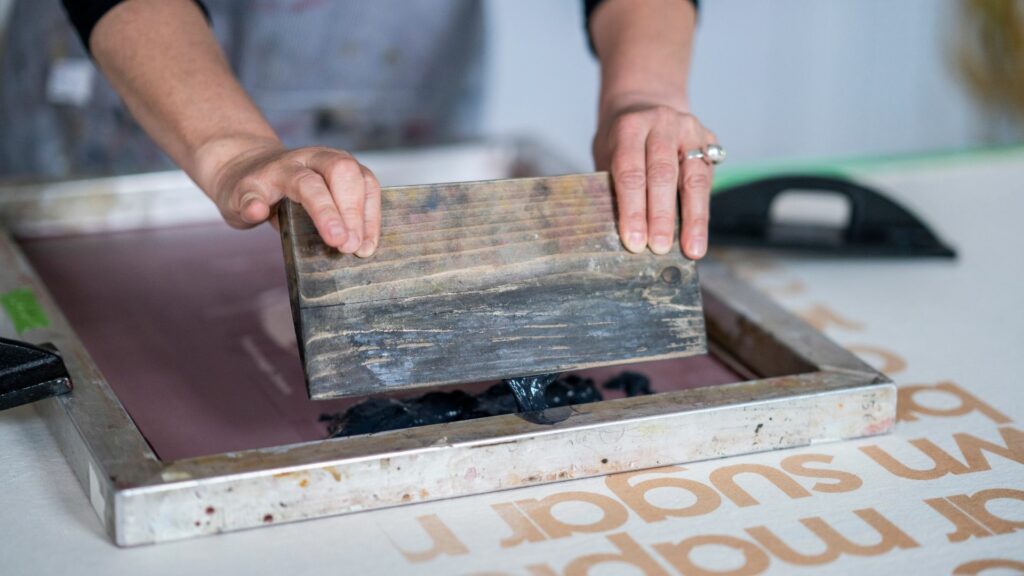
You could take some time to experiment with your printing process for better results first. Take time to learn how to prepare screens, how to register the garment, how much ink to apply, printing techniques, and so on. It’ll take a fair bit of trial and error to know what’s suitable for your prints, but once you’ve mastered the basics, you can immediately start printing and selling your garments.
With a good setup and the right shop conditions, entry-level printers can easily print 100 shirts in an hour. Speeds will vary based on factors such as the design you’re printing, the number of colors to use, how long it takes to flash and cure inks, and so on. Preparing screens early can also help to shave off some of your production time, allowing your team to go to the press and start printing quickly (and with great results).
However, EO setups are meant for new screen printers and aren’t ideal for bigger printing orders. A good setup allows you to print faster, but you’ll still need additional tools and trained staff to fulfill larger orders. Moreover, multicolored jobs can take a significant amount of time owing to the additional required screens for each color. While it might be tempting to start with small print runs of under 30 shirts, the time and cost investment for such short runs will only cost you more than it will for bigger runs.
A Complete, Professional Setup
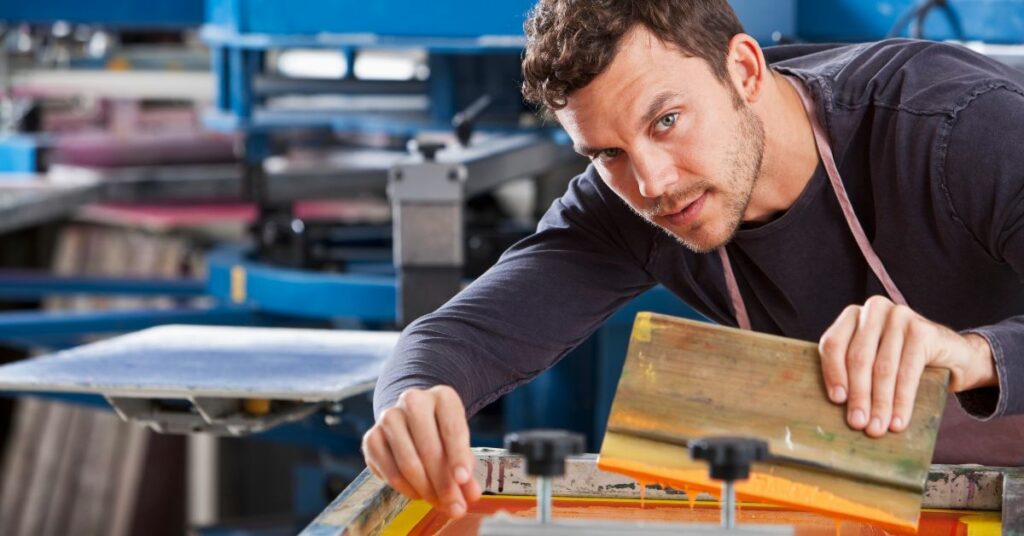
If you have a larger team and know what you want from your screen printing business, or if you’ve already been established for some time and want to expand, the complete setup will be what you need to scale up your business.
- 6-color/6-station (or higher) screen printing presses: Good quality multi-station presses, like Riley Hopkins presses, can go for $5,000 and higher.
- Desktop printer and transparent acetate film/paper for your designs: 13”x100’ transparency rolls are $40 and higher. These are more cost-effective than buying single sheet packs.
- Mesh screens: You should have 110, 156, and other mesh counts for specialty inks and designs. Larger screens are also available, if needed, going around $40 for 23”x31” screens and above $50 for 25”x36” screens.
- Inks and liquid emulsion: Larger quantities of ink can be bought at wholesale/discounted prices from particular sellers. You could also use capillary film instead of liquid emulsions. One example is Chromaline’s MagnaCure 26”x15’ films, priced at about $120.
- Squeegees: Having multiple squeegees with different durometer levels and layers can be helpful for various types of jobs. A triple-layer squeegee (70/90/70 durometer) with an aluminum handle can cost about $25.
- Scoop coater for the emulsion: You can get a 6” scoop coater for $11 or more. Longer ones, such as a 14” length, can cost about $20 and higher.
- Flash dryers for setting inks: 18”x24” flash dryers are priced from $1,000 and above. You could also get a forced air dryer if you’re using water-based inks; these go from $2,000 and above.
- Exposure units: A 23”x31” exposure unit with a vacuum lid can go for $2,000 or more.
- Conveyor dryer for curing: Because of the volume of prints you’ll be making, a longer conveyor dryer is what you’ll need. An 8’x24’ conveyor dryer can go for $7,500 and higher.
- Washout booth/room and dunk tanks: Simple washout booths can cost around $300 or more, while top-quality dunk tanks can go for $400 and higher. You could potentially nab a darkroom kit for the price of $3,750 or so.
- Screen racks/carts: You can either build a rack of your own or buy a simple wheeled rack for about $30 – just make sure that it can take the press’s weight into account before buying one. Dedicated screen printing press racks can go for $400 or so.
- Cleaning supplies: Brushes, hoses, and degreasers (among other things) come at various costs. You may want to consider investing in a power (or pressure) washer for faster, easier cleaning of screens.
A complete setup may cost you anywhere from $20,000 and above, depending on what brands you purchase. Again, ScreenPrinting.com has a decent deal for a complete set going for $21,995 (offer price). Other equipment can be added where needed.
With the professional setup, you’ll be able to boost productivity exponentially thanks to the variety of auxiliary equipment that can help shave off production time without affecting your output quality. Larger presses (and more of them) mean your team can print many more garments in a single day. Conveyor dryers allow multiple printed garments to be dried and prepped for packaging. Washout booths and/or dunk tanks can make cleaning and reclaiming screens much easier. All of this combined gives you unprecedented speed while maximizing your profit growth.

Naturally, pursuing such a complete setup will require a significant investment for each piece of equipment you need. However, you can quickly recoup your investment costs once you’re set up and printing, mainly if you can quickly produce hundreds of garments in a single day for a reasonable price. Nevertheless, consider the increasing overheads you’ll need to pay for – utilities being chief among them, your team’s wages, maintenance costs, and so on. Long-term planning is essential to keeping your business profitable.
You’ll easily be able to print on a range of different substrates, such as cotton, blends, and even polyesters, to cater to various customer wants and needs. Screen printing’s versatility enables you to easily take on eclectic orders, from glitter typography prints to halftone gradients for photograph-quality designs. And with specialized heat presses and platens, you’re not limited solely to garments only. Ever wanted to try screen printing on a cap? Now you can!
One downside comes from downtime. This can be due to maintenance or equipment issues, ultimately proving costly in the long run. The longer you’re not printing, the fewer profits you earn from your garments. Troubleshooting EO setups is not a big hassle since much of it requires manual work and minimal repairs, especially if you take good care of your equipment. With professional setups, you’ll want regular maintenance schedules to ensure that your printing won’t be interrupted without warning.
The Automatic Setup
A fully automatic setup means you need fewer people printing, focusing instead on ensuring the machines run optimally and produce consistent results. You may need a team to move printed garments that need to be cured from the press to the conveyor dryer and to prepare them for packaging and shipping.
- Automatic screen printing presses: Examples include M&R’s STRYKER model and Lawson’s Trooper model. These presses are packed with valuable features and tech, so prices start from $30,000 or higher.
- Mesh screens: You should have 110, 156, and other mesh counts for specialty inks and designs. Larger screens are also available, if needed, going around $40 for 23”x31” screens and above $50 for 25”x36” screens. Be sure to purchase screens compatible with your automatic systems.
- Automatic screen coating system: These machines automate the process of coating screens with emulsion. As with all automated systems, these have a price tag above $20,000.
- Computer-to-screen (CTS) imaging system: These systems automatically burn screens with your desired design. Some machines also have built-in exposure units. CTS system costs can go from $30,000 to $80,000.
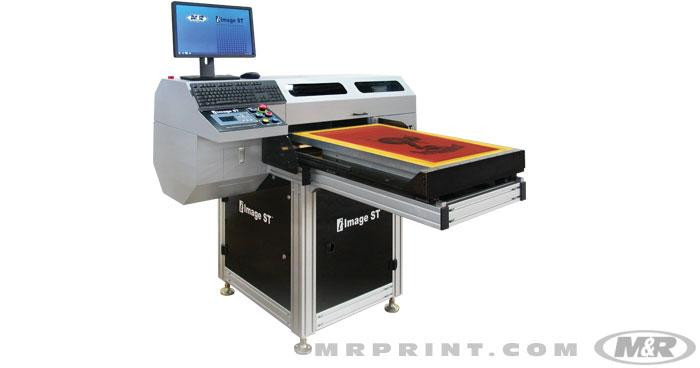
- Inks and liquid emulsion: Larger quantities of ink can be bought at wholesale/discounted prices from certain sellers. If you use automatic screen coaters, you’ll need to purchase emulsions that are compatible with these systems.
- Replacement squeegees for the automatic systems
- Auxiliary exposure units: If you don’t use a CTS system with a built-in exposure unit, you can purchase additional exposure units that meet your needs. If you want a larger unit, say 36”x48”, you can get one for $4,500 and above.
- Flash cure units: There are compatible flash cure units you can pair with an automatic press for gelling inks for multicolored runs. These can cost around $3,000 or higher.
- Conveyor dryer for curing: Because of the volume of prints you’ll be making, a longer conveyor dryer is what you’ll need. An 8’x24’ conveyor dryer can go for $7,500 and higher.
- Automatic screen rinsing/cleaning & reclaiming systems: Automatic screen rinsing automates rinsing exposed screens, while the latter system automates cleaning up and reclaiming used screens. All of this is done in a self-contained environment. For their size and capabilities, expect the price tag to go anywhere above $30,000.
- Light-safe screen storage racks/areas: A light-safe storage area ensures screens can be reused for future orders. You could also get handy mobile storage containers for just under $2,000.
While your production speeds significantly increase thanks to fast but accurate automatic systems, getting this impressive production quality comes with a very hefty price. A top-of-the-line automatic printing press can cost anywhere from $30,000 and above, excluding everything else. The considerable investment ceiling means that only large companies can afford this setup, but the long-term cost savings are very substantial.
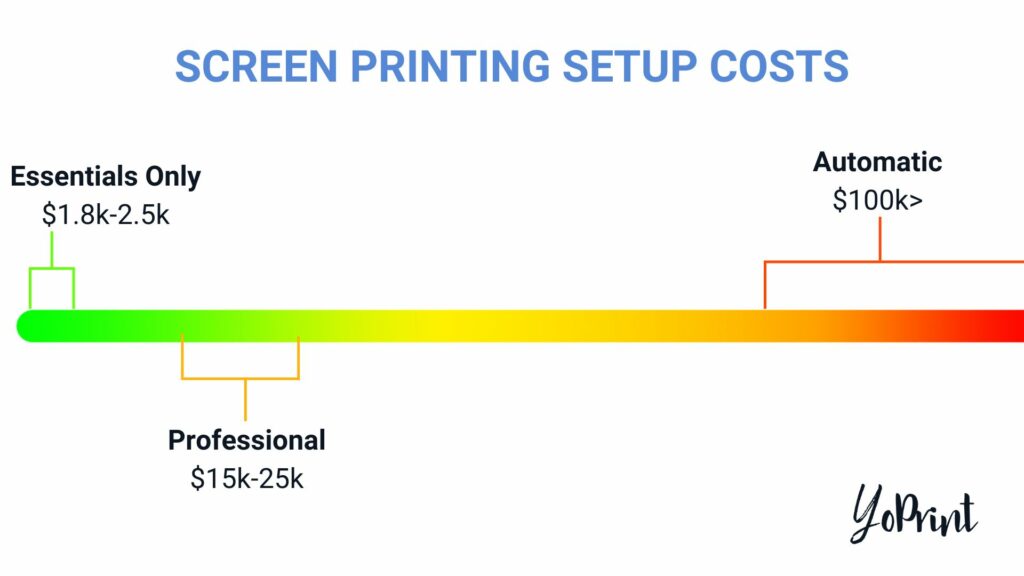
With an automatic setup, you can reduce your overall labor costs since nearly everything in the screen printing process is now automated. From preparing screens to printing garments, you only need staff on hand to monitor the machines, look out for potential issues, and move garments to and from the press, as well as to and from the dryer.
Moreover, the time savings from an automatic setup is incredible. If a traditional manual printing run of 500 shirts could be completed in eight hours, a similar run handled by an automatic setup can effortlessly complete it in under an hour. In fact, you can print far more garments than you usually would by manual means and in record time, too. You’ll also enjoy the same print quality as a professional printing setup.
The time you now have available as your setup runs on its own can be used to up your marketing game and generate new sales, helping you grow your revenue stream even further. A high production rate, excellent efficiency, and long-term cost reduction make for a speedy yet effective printing business.
What you will need, though, is specialization and training to operate all your automatic equipment. Getting technical support is one thing, but it’s another to know how to resolve issues when they arise quickly. Staff training is essential to keep production going smoothly while keeping an eye out for potential problems. Frequent maintenance cycles will also help to keep your equipment going for longer. Remember that downtime will cost you every minute that you’re not printing.
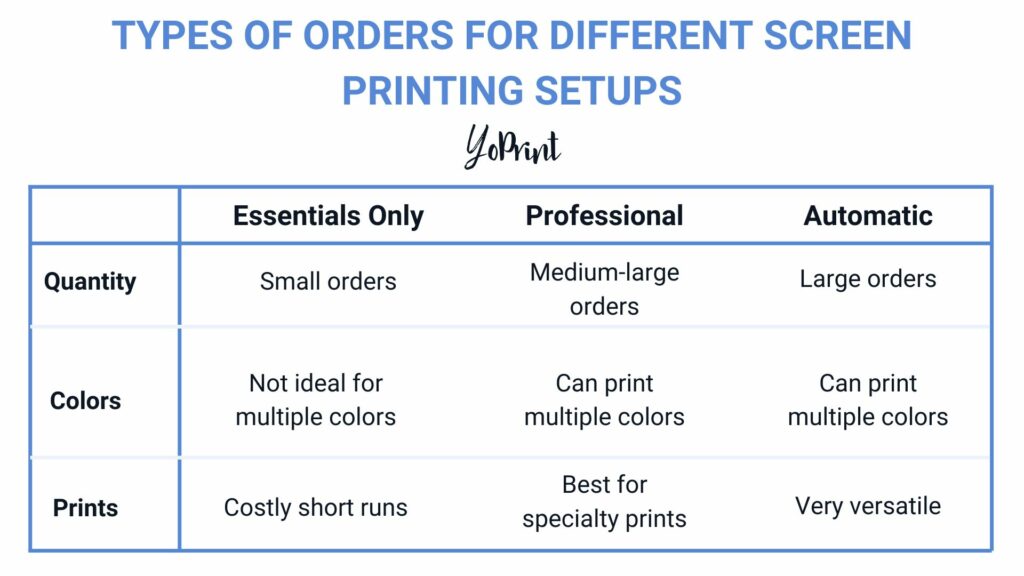
What Works for My Business?
Now that you know what screen printing is, the next step is to find a niche to sell your garments to potential customers. You could sell your garments directly to customers, either from a physical storefront or online, or you could offer your services as a contract printer or instead have a contract printer for specific jobs.
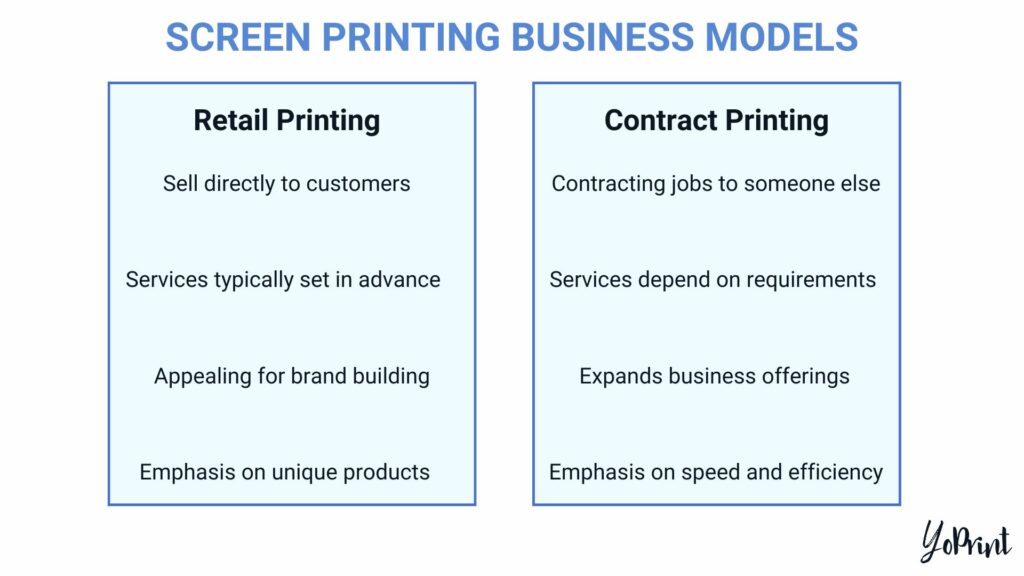
The first option, retail printing, is the most straightforward business model since you’ll sell directly to customers. You’ll offer them a catalog of your services and outline the types of garments available, the design(s) they can pick (or provide their designs to you), the number of colors to use, and more. You’ll also outline the restrictions to what you can do to temper customer expectations.
While you can solely offer screen printing services to customers, you’ll eventually run into customers who would want specific features to be added to their orders. This may include embroidery, special effects, or even other types of merchandise. You can branch out into these areas, allowing you to cater to many different customers’ needs, or you could hire a contract printer to help you with these.
Contract printing involves contracting another business to provide services that your business doesn’t. In the case of the above example, you could subcontract an embroidery shop to help you make the embroidery the customer wants. You’ll then pay them an agreed amount for their services, usually at a rate lower than retail printers.
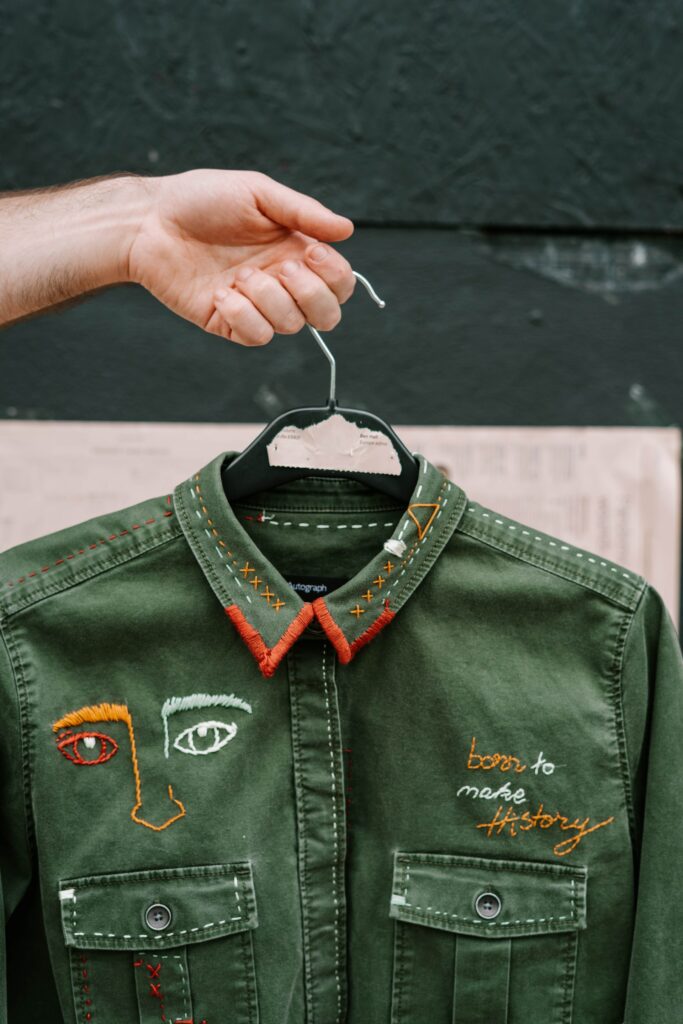
Contract printing is also provided to brands and organizations requiring unique garments and other merchandise for events, sports teams, and more. Such an arrangement can be lucrative in the long term, as you now have a steady revenue stream to cater to their various needs every year.
Retail printing is appealing if you want to build a brand. By offering customers options for what they want, you can price your garments accordingly for various available services. You can easily mark up prices for each service you offer. Contract printing, on the other hand, emphasizes speed and efficiency. Your customer tells you what they need and when they need it, and you’ll fulfill their request within the specified timeframe.
While retail printing on its own will help you rake in good profits, contract printing services can be a great way to expand your business even further. You can contract difficult jobs to contract printers while focusing on the core of your business and marketing your brand. Taking on contract printing jobs from others can also do wonders to help boom your business.
The Final Say

We’ve provided everything you need to know about screen printing. Ultimately, you’ll have to decide what will work best for your screen printing business based on your budget and business plan. New to screen printing? A setup comprising the essential starting equipment is just what you need to start printing garments. Already run a printing business? A professional setup will help you leverage your existing sales to open up a new (and exciting) revenue stream.
Screen printing is here to stay even as printing technologies have grown substantially. The advent of automatic screen printing presses and other automation systems continues to help screen printers get the most out of their time, money, and effort while producing unique garments in large quantities for their wide range of customers.
